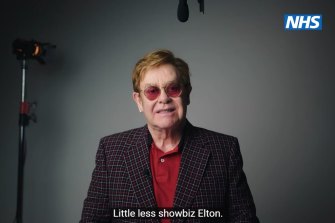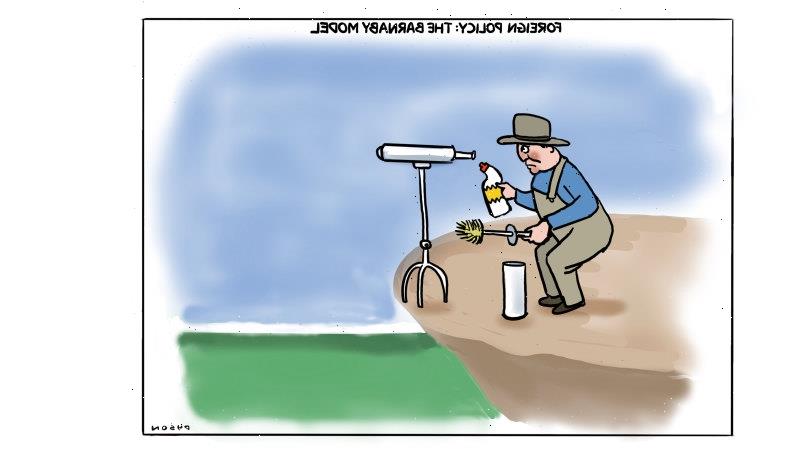What makes an effective COVID ad? Elton John and Michael Caine, for starters.
The UK’s lighthearted campaign to encourage Britons to get vaccinated was among the earliest of a spate of viral COVID ads that drew praise for their clever and engaging approach, a public service message with an entertaining twist.
Elton John stars alongside Michael Caine in an ad for the UK’s National Health Service. Credit:YouTube
For Australians fed hard facts, it also proved we’ve been shortchanged.
Almost six months since the government first announced the rollout of a $24 million ad campaign aimed at building popular confidence around COVID vaccinations, our offerings have mostly drawn scorn – labelled “boring”, “ineffective” and likened to something produced by “a Communist government committee”.
Dee Madigan, executive creative director from Campaign Edge and a panel regular on ABC’s Gruen, says Australia’s campaign fails advertising’s first goal.
“Ads need to cut through, that’s the most important thing. You can say everything you want, but if people don’t pay attention you’ve wasted your time,” Madigan says. “That’s the problem with the Australian one, it’s literally wallpaper. Even though all the messages are right, it’s just boring.”
Melinda Geertz, CEO of Leo Burnett Australia, says the Australian campaign is “effectively an infomercial”.
“It presents facts, but it doesn’t make me feel anything. Facts inform people, but emotion changes their behaviour.”
The most popular overseas campaigns have evoked comedy skits, big-budget Hollywood tear-jerkers and catchy music videos, tying their COVID messaging to creative out-of-the-box thinking.
New Zealand’s viral Ka Kite, COVID became an online favourite thanks to its optimistic warmth. “Hey COVID, you were a bit of an egg in 2020, eh?” a young girl asks before the ad pitches vaccines as the “metaphorical door to freedom” and highlights the nose-touching possibilities of immunity.
The US’s Back in the Game, an emotional spot set to the strains of Willie Nelson singing Billie Holiday’s I’ll Be Seeing You, targeted sporting enthusiasts and the post-vaccination potential of sitting alongside fellow fans watching Joel Embiid dominating an NBA playoff game or Serena Williams winning another grand slam.
Singapore’s manic Get Your Shot, Steady Pom Pi Pi is something else entirely, a disco-tinged music video featuring TV star Gurmit Singh as his hit sitcom character Phua Chu Kang urging people to get vaccinated in song.
The tonal differences between them all proves there’s not one single way to tackle a COVID ad, says Madigan.
“The New Zealand one has beautiful performances, it’s well-written and engaging. Singapore’s one is just so memorable, you want to sing along with it. And the UK ad features celebrities, which gives you added cut-through immediately.”
Would it be worth our campaign tapping one of our own cultural icons? Everyone loves Hugh Jackman, for example. Or even Thor himself, Chris Hemsworth?
“You could do it like that. Especially when we have such little trust in the government, people might have more trust hearing the message from a well-known celebrity,” says Madigan.
“But while a celebrity is a good start, you also need it to be clever and well-written, which is why the UK one is so strong. And even though celebrities are effective in hitting specific demographics, I think what we need right now is a really broad campaign that works for everyone.”
Dr Abas Mirzaei, senior lecturer in marketing at Macquarie University, says Australia’s campaign could still prove effective given its “focus on assurance and reassurance”, especially with ongoing concerns around blood clots linked to the AstraZeneca vaccine.
“But perhaps a balance of information and emotion would work much better,” he says, pointing to the US ad’s “forward-looking promise”.
“The Australian ad doesn’t say anything about the benefits of getting the vaccine and its positive impact on our lives. Ideas around getting back to normal, togetherness, and celebration are completely missing.”
While many locals have praised the humour utilised in campaigns overseas, it’s debatable whether such playful levity is appropriate in Australia, where minimal COVID cases have created a lax response to vaccinations.
“Fear and hope are powerful, and we could use those emotions to jolt people out of complacency or avoidance and into action,” says Geertz.
Madigan agrees, adding people need to be given a reason why they need to be vaccinated.
“The problem with Australia is the urgency’s gone off the boil, so a little bit of fear can be impactful. Fear works because it gets people’s attention; we’re hard-wired to notice bad things.
“We could remind people that Singapore was sitting pretty a couple of weeks ago and now it’s not, which shows how quickly things can turn,” she says. After months of minimal cases, the island nation is suddenly facing an average 39 new cases a week.
“Humour’s good, but I feel in Australia at the moment it’s not enough; we’re a little lackadaisical as it is,” says Madigan. “I’d be pushing the idea of ‘Hey, look at how quickly things can change, and this is a way to stop that happening.’ We need people to be scared.”
Most Viewed in Culture
From our partners
Source: Read Full Article



